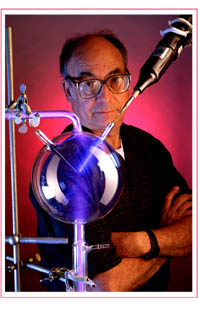Scientists have brought a 1950s science experiment back to life, and with it discovered a lot more about how life on Earth got stated in the first place.
 In the 1950s UCSD scientist Stanley Miller made history when he recreated the conditions of the early Earth by mixing some water, methane, hydrogen and ammonia in a glass bottle, boiling the result and zapping it with some synthetic lightning. In the residue remaining he identified 5 types of "amino acid", the building blocks used by life to create proteins. This, he said, strongly argued that "Darwin's warm little pond" from which life sprang 4 billion years ago, was spawned by the early Earth itself.
In the 1950s UCSD scientist Stanley Miller made history when he recreated the conditions of the early Earth by mixing some water, methane, hydrogen and ammonia in a glass bottle, boiling the result and zapping it with some synthetic lightning. In the residue remaining he identified 5 types of "amino acid", the building blocks used by life to create proteins. This, he said, strongly argued that "Darwin's warm little pond" from which life sprang 4 billion years ago, was spawned by the early Earth itself.
Miller died last year but his colleagues, in clearing up his things, discovered notebooks, the original apparatus and the resulting residues that he produced in his experiments fifty years ago.
Now, in a paper in this week's Science, they describe how they re-analysed Miller's material using ultra-sensitive modern chemical analytical techniques. Rather than just 5 of life's building blocks it would appear that Miller had actually made many more. The team, led by UCSD scientist Jeff Bada, document 22 amino acids and at least 5 other amine chemicals in the vestiges of the experiments. This shows, they say, that the conditions on the early Earth could well have produced a host of life-giving chemicals, rather than the handful suggested previously.
- Previous Colourful dreaming
- Next Gecko Glue










Comments
Add a comment